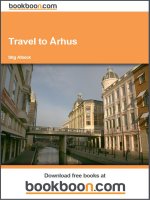Travel to Rio de Janeiro pot
Bạn đang xem bản rút gọn của tài liệu. Xem và tải ngay bản đầy đủ của tài liệu tại đây (4.25 MB, 37 trang )
Download free ebooks at bookboon.com
Download free ebooks at bookboon.com
Rio de Janeiro
© 2008 Stig Albeck & Ventus Publishing ApS
Translation: Maria Lundberg
All rights and copyright relating to the content of this
book are the property of Ventus Publishing ApS, and/or its
suppliers. Content from ths book, may not be reproduced
in any shape or form without prior written permission from
Ventus Publishing ApS.
Quoting this book is allowed when clear references are made,
in relation to reviews are allowed.
ISBN 978-87-7061-263-0
1st edition
Pictures and illustrations in this book are reproduced according
to agreement with the following copyright owners
Riotur.
The stated prices and opening hours are indicative and may
have be subject to change after this book was published.
Download free ebooks at bookboon.com
Rio de Janeiro
OnLibri.com
4
Kapiteloverskrift ONLIBRI
Download free ebooks at bookboon.com
Rio de Janeiro
OnLibri.com
5
A visit to Rio de Janeiro
www.riodejaneiro-turismo.com.br
www.rio.rj.gov.br
www.turismo.gov.br
Few cities cause as much happiness as Rio de
Janeiro. Samba, soccer, the colourful, annual
carnival as well as the beaches Copacabana and
Ipenema are only a few of the many things that
await the visitors.
The highlights of the city are literally speaking the
characteristic Sugar Loaf Mountain and the
impressive Statue of Christ, which is watching and
embracing the entire Rio de Janeiro. A visit to the
statue is a must on a trip to the charming Brazilian
metropolis.
Besides the good possibilities of bathing and
relaxing, Rio de Janeiro also has many cultural
offers, for example fine museums and interesting
churches, and of course all the Cariocas, which is
the local name of the citizens of Rio de Janeiro.
Fortunately, you can’t avoid being infected by their
good mood.
Have a nice trip!
A visit to Rio de Janeiro
Download free ebooks at bookboon.com
Rio de Janeiro
OnLibri.com
6
Historical outline
The first European presence in the present Rio de
Janeiro area occurred in January 1502, when the
Portuguese explorer Gaspar de Lemos was in
charge of an expedition, which sailed to the
Guanabara Bay. They believed that the bay had to
be the mouth of a river, and therefore they named
the place Rio de Janeiro, which means the River of
January in Portuguese.
For years France tried to gain influence in the area,
and in 1555 they took the areas around the
Guanabara Bay under the leadership of Admiral
Villegaignon, but after several battles, they had to
leave the country again a few years later.
In 1565, Estácia de Sá founded the city São
Sebastião do Rio de Janeiro at the foot of the
Sugar Loaf Mountain. The city was named after
the Portuguese king. The city was well situated
with its natural harbour in the Guanabara Bay but
still close to the Atlantic Ocean, from where the
city was subject to repeated lootings, not least
from enemies of Portugal.
Portugal was colonising the enormous country
Brazil, and in order to avoid conquests from other
Europeans, they founded the many new cities. Rio
de Janeiro was also made the second regional
administrative centre after Salvador to the north.
In that way, a faster extension was secured in the
southern part of the colony.
For many years, the economic development was
slow, and Rio de Janeiro remained a small city.
Slowly the region was cultivated, as the production
did increase, and at the end of the 17th century,
the production of sugar canes was important as
well as the largest export good.
At the beginning of the 18th century, gold was
found in Minas Gerais, inland and north-west of
Rio de Janeiro. A gold fever broke out, which
attracted people from both Portugal and the other
regions of Brazil. The King of Portugal decided
that all gold from Brazil was to be shipped from
Rio de Janeiro, and this created economic growth
and increased the number of inhabitants in the city.
In 1763 Rio de Janeiro was made the only
administrative centre of Brazil, and by that in
reality the capital of the colony, which naturally led
to quite a few new public institutions in the
Portuguese administration.
The Portuguese King Dom João VI was forced to
leave his home country due to Napoleon's
conquests in Portugal in 1808, and on that
occasion, he moved his entire court to Rio de
Janeiro. The royal status of the city created
additional buildings, among others the residence
of the king, and this supplied the city with a
cultural wealth, which it had never known before.
The official capital of the kingdom was moved to
Rio de Janeiro, which then also became the
European capital.
In 1821 Dom João went back to Lisbon, and the
year after, his son declared Brazil independent and
named himself Emperor Pedro I. He kept Rio de
Janeiro as capital. In 1831 Emperor Dom Pedro I
removed the government, and after a lot of
turmoil and a failed attempt to re-establish the
political rule, he left Brazil, boarded a British
warship and left the throne to his 5-year old son,
who became Emperor Dom Pedro II in 1841.
Rio de Janeiro developed rapidly through the last
half of the 19th century. The railway came to town
in 1858, and 10 years later the first tram appeared
in the city streets. Still more people came to Rio de
Janeiro, and this led to a pressure on the
development of new urban areas.
In the beginning of the 20th century, a large
expansion of the city begun. In the centre, wider
boulevards were established, and the Zona Sul,
which is situated south of the centre and the
Historical outline
Download free ebooks at bookboon.com
Please click the advert
Rio de Janeiro
OnLibri.com
7
mountains going through the city, was planned.
Thereby, the street life around the Copacabana
beach, which was earlier situated outside of Rio de
Janeiro, arose. In the 1930’es, the Copacabana
Palace Hotel was one of the most fashionable
hotels of the American continent, and in this
period, the city got a reputation for being the
capital of beaches and happiness.
Gradually, the large city of São Paola had taken
over the role of Rio de Janeiro as the economic
locomotive of Brazil, whereas a number of cultural
institutions were built in the capital through the
20th century. In 1905 the building of the city’s
new theatre was started, and many museums were
established all around the many districts in the city.
As a capital, Rio de Janeiro and its increase in
tourism continuously attracted a lot of people
from especially the poor regions in the north-east
of Brazil. They settled in the north-west outskirts
of the city, which gradually turned into large
districts with millions of inhabitants. The districts,
the so-called favelas, often consisted of extremely
temporary houses, and the inhabitants lived their
own lives, far from the touristy Rio de Janeiro,
which primarily was the southern Zona Sul.
For years, it had been discussed whether the
capital of Brazil should be moved inland to
develop the area. This became a reality in 1960,
where Brasilia was founded, and by that the status
of Rio de Janeiro as the country’s capital ended.
Historical outline
Download free ebooks at bookboon.com
Rio de Janeiro
OnLibri.com
8
Tour 1: Rio de Janeiro
1. Centro Cultural Light
Avenida Marechal Floriano 168
Metro: Presidente Vargas
This building was built in 1911 as the headquarters
and garage for the tram car company Light. The
style is American Renaissance.
In 1944 the place was converted into a cultural
centre with a number of exciting exhibitions about
the history and development of Rio de Janeiro,
among other things, in the room Espaço Rio
Antigo, you find some exciting historic
photographs from the earlier Rio de Janeiro.
2. São Bento Monastery/
Mosteiro de São Bento
Rua Dom Gerardo 68
Metro: Uruguaiana
This monastery was founded in the 16th century.
The present buildings have been built in the 17th
century, and they are some of the most impressive
buildings of Rio de Janeiro. As one of the three
golden churches of Brazil, the interior is
completely covered in gold; an amazing sight in
the rich ornamentation.
3. Igreja de Candelária
Praça Pio X
Metro: Uruguaiana
Between modern buildings in the financial centre
of Rio de Janeiro, the beautiful Candelária Church,
which was built in the 18th century, is situated.
The ornamented façade of the church is very
elegant, and inside the church you can see
beautiful murals.
4. Centro Cultural Banco do Brasil
Rua Visconde de Itaboraí 78
Metro: Uruguaiana
In 1989 this cultural centre opened in the building,
which was built in 1880 as the headquarters for the
bank, Banco do Brasil. There are always a number
of activities going on in the centre, which among
other things has two theatres, cinemas and not
least four exhibition rooms, where you can see
changing exhibitions.
Tour 1: Rio de Janeiro
Download free ebooks at bookboon.com
Rio de Janeiro
OnLibri.com
9
5. Confetaria Colombo
Rua Gonçalves Dias 32
Metro: Carioca
The distinguished restaurant Confeitaria Colombo
is an extravaganza from the Brazilian Belle Époque
period. The atmosphere is just like in the
beginning of the 20th century with magnificent
frames in Art Nouveau style. Among the many
details of the place, you find the Belgian mirrors,
Italian marble interior and furniture, which is
typical for the time.
6. Praça XV
Praça XV
Station: Carioca
On the this square, a part of Rio de Janeiro’s
historical events have taken place, e.g. the King of
Portugal disembarked here in the beginning of the
19th century, and in 1889 the Brazilian Emperor
Pedro II set off from here after being banished
from the country.
7. Museu Historico Nacional
Praça Marechal Âncora
www.museuhistoriconacional.com.br
Metro: Carioca
The Museum of National History of Brazil
describes the history of the country in an exciting
and vivid way through its large collection. The
museum itself is placed in three buildings, which
have been built between 1762 and 1835.
8. Museu de Arte Moderna
Tour 1: Rio de Janeiro
Download free ebooks at bookboon.com
Please click the advert
Rio de Janeiro
OnLibri.com
10
Avenida Infante Dom Henrique 85
www.mamrio.org.br
Metro: Cinelândia
In the exciting museum building from 1958, you
can see approximately 11 000 Brazilian and
international works of modern art. The museum
also has a popular cinema.
9. Museu Nacional de Belas Artes
Avenida Rio Branco 199
www.mnba.gov.br
Metro: Cinelândia
At the National Art Museum, you can see a large
collection of Brazilian works primarily from the
19th and the 20th centuries. However, you can
also see the painting by Leandro Joaquim of Rio
de Janeiro from the 18th century. Also, you can
find works by the country’s famous modernist,
Cândido Portinari.
Tour 1: Rio de Janeiro
© Deloitte & Touche LLP and affiliated entities.
360°
thinking
.
Discover the truth at www.deloitte.ca/careers
© Deloitte & Touche LLP and affiliated entities.
360°
thinking
.
Discover the truth at www.deloitte.ca/careers
© Deloitte & Touche LLP and affiliated entities.
360°
thinking
.
Discover the truth at www.deloitte.ca/careers
© Deloitte & Touche LLP and affiliated entities.
360°
thinking
.
Discover the truth at www.deloitte.ca/careers
Download free ebooks at bookboon.com
Rio de Janeiro
OnLibri.com
11
10. Theatro Municipal
Praça Marechal Floriano
www.theatromunicipal.rj.gov.br
Metro: Cinelândia
The beautiful and richly ornamented theatre of Rio
de Janeiro has mainly been built in Carrara marble.
Both the inside and the outside of the theatre are
an experience, and it was built from 1905 to 1909
with inspiration from the opera of Paris.
Tour 1: Rio de Janeiro
Download free ebooks at bookboon.com
Rio de Janeiro
OnLibri.com
12
Tour 2: Rio de Janeiro
11. Catedral Metropolitana
Avenida República de Chile
Metro: Cinelândia/Carioca
This modern cathedral, which is 96 metres tall,
almost looks like an enormous lamp shade with its
cut through conic shape. With its coloured
windows, the light gives you a very beautiful
experience inside the large room.
In the lower floor of the cathedral, an exciting
museum, which exhibits interesting effects from
the Brazilian history, has been established. Here
you find among other things the throne and the
baptismal font of the royal family.
12. Arcos da Lapa
Largo da Carioca
Metro: Cinelândia/Carioca
Arcos de Lapa is also known as the Carioca
aqueduct, and it was built from 1724 in order to
transport fresh water to the increasing population
of Rio de Janeiro. Today a tram line has been
established at the top of the aqueduct; here you
can go to the Santa Teresa area. The aqueduct
itself is situated in the Lapa area, which has been
one of the city’s leading districts of entertainment
since the beginning of the 1950’es. Known as
Montmartre, Carioca has throughout the years
attracted artists and intellectuals.
Tour 2: Rio de Janeiro
Download free ebooks at bookboon.com
Please click the advert
Rio de Janeiro
OnLibri.com
13
13. Santa Teresa
Santa Teresa
Metro: Glória
The district of Santa Teresa was established in the
18th century, and today the atmosphere feels like
going back to the historical Rio de Janeiro. Narrow
and crooked streets with old trams, which turn the
corners, are some of the things that make Santa
Teresa special. Besides, the old squares and the
cosy park, Parque des Ruínas, of Santa Teresa is
worth visiting.
14. Palácio do Catete
Tour 2: Rio de Janeiro
Increase your impact with MSM Executive Education
For more information, visit www.msm.nl or contact us at +31 43 38 70 808
or via
the globally networked management school
For more information, visit www.msm.nl or contact us at +31 43 38 70 808 or via
For almost 60 years Maastricht School of Management has been enhancing the management capacity
of professionals and organizations around the world through state-of-the-art management education.
Our broad range of Open Enrollment Executive Programs offers you a unique interactive, stimulating and
multicultural learning experience.
Be prepared for tomorrow’s management challenges and apply today.
Executive Education-170x115-B2.indd 1 18-08-11 15:13
Download free ebooks at bookboon.com
Rio de Janeiro
OnLibri.com
14
Rua do Catete 153
Metro: Catete
The Catete Palace was the residence of the
Brazilian government between 1897 and 1960, and
many decisions in the country’s history have been
made here by the 18 presidents who had their
office here.
The façade in new classic style is made of granite
as well as red and white marble. The beautiful
rooms of the palace were opened for visitors as a
museum in 1960, when the capital of Brazil was
moved to the newly established Brasilia.
15. Parque Guinle
Rua Gago Cutinho/
Rua Paulo César de Andrade
Metro: Largo do Machade
This park and the surrounding housing sectors
were designed and laid out in 1948 by the
Architect Lúcio Costa. The modern construction
was made with inspiration from the thoughts of Le
Corbusier, and the buildings have been the model
for the large block of flats in Brasilia, which later
became capital of the country.
16. Museu da Chácara do Céu
Rua Murtinho Nobre 96
Metro: Cinelândia
The Industrialist Raymundo Ottoni de Castro
Maya collected the many works of art, books,
ceramic works and furniture, which you can now
see in the exhibitions at the Museum Chacara do
Ceu. In the fine collection, you find works by
among others Dali, Miró, Matisse and Picasso.
17. Museu Internacional de arte Naïf
Rua Cosme Velho 561
Metro: Largo do Machado
At this museum, you can see more than 8 000
works of primitive art from more than 130
countries, and of course not least Brazilian art. The
works date back to the 15th century, and one of
the most interesting pieces is the 7x4 metres large
painting of Rio de Janeiro.
18. Statue of Christ/Cristo Redentor
Rua Cosme Velho 513
www.corcovado.com.br
Metro: Estácio/
Largo do Machado, tåg från Cosme Velho
The world famous Statue of Christ at the top of
the 710 metres tall mountain, Morro do
Corcovade, is the symbol of Rio de Janeiro. The
statue is 38 metres tall, and it was inaugurated in
1931. Access to the exceptionally situated place
has been improved in the last few years, and on
the way up to the statue, you can now get a lot of
information about the statue itself, the place, and
the unique sight that the Corcovado Mountain is.
From here you can admire the location of the
Brazilian city, which is one the most beautiful
locations in the world.
Tour 2: Rio de Janeiro
Download free ebooks at bookboon.com
Rio de Janeiro
OnLibri.com
15
Tour 2: Rio de Janeiro
Download free ebooks at bookboon.com
Please click the advert
Rio de Janeiro
OnLibri.com
16
Tur 3 Rio de Janeiro
19. Sugar Loaf Mountain/
Pão de Açúcar
Avenida Pasteur 520
www.bondinho.com.br
Station: Botafogo
The Sugar Loaf Mountain is the famous 396
metres tall granite mountain, which is shaped
exactly like a sugar loaf. The mountain is one of
the symbols of Rio de Janeiro, and there is access
to the top of it. There is a funicular over the
mountain, Morro de Urca, in 220 metres altitude
before you get to the top of the Sugar Loaf
Mountain, where you are rewarded with an
outstanding view.
20. Copacabana
Avenida Atlântica
Station: Cardeal Arcoverde/Siqueira Campos
Tour 3: Rio de Janeiro
Get “Bookboon’s Free Media Advice”
See the light!
The sooner you realize we are right,
the sooner your life will get better!
A bit over the top? Yes we know!
We are just that sure that we can make your
media activities more effective.
Download free ebooks at bookboon.com
Rio de Janeiro
OnLibri.com
17
In total, there are 80 km of beach in Rio de Janeiro
and in the immediate vicinity of Rio de Janeiro,
and of them, the divinely beautiful Copacabana is
the most famous. The beach is three km long and
is framed by the sea and the many white buildings
of Avenida Atlantica.
There is always a riot of people at the popular
beach. A cycle track, kiosks, restaurants, and of
course the beach and the water themselves are
only some of the things that attract people to
come here.
21. Copacabana Palace
Avenida Atlântica
Metro: Siquera Campos
This impressive hotel was built as one of the first
along the famous Copacabana Beach, and it was
opened in 1923. With its European inspiration and
luxurious decorations, the hotel became one of the
famous places in Rio de Janeiro, and it attracted
politicians, actors, and other well-known people
from all over the world.
The hotel was the scene for the movie ”Flying
down to Rio”, where Fred Astaire and Ginger
Rogers danced together for the first time.
22. Copacabana Fort/
Forte de Copacabana
Praça Coronel Eugênio Franco
Metro: Siqueira Campos
At the end of the Copacabana Beach, the
Copacabana Fort is situated farthest out on a point.
It was built in 1914 as a defence for the areas in
Guanabara Bay.
At the fort, you can visit the city’s Museum of
Military History, Museu Histórico do Exército,
which in an exciting way describes the history of
the fort and other things.
When visiting here, you can also enjoy one of the
most beautiful views of the coastline, the sea and
Rio de Janeiro.
23. Praia de Ipanema
Tour 3: Rio de Janeiro
Download free ebooks at bookboon.com
Rio de Janeiro
OnLibri.com
18
Praia de Ipanema
Metro: Siqueira Campos
The Ipanema Beach was immortalized by the
song ”Girl from Ipanema”, and when visiting this
place, you understand why. The beach in itself is
very beautiful and fascinating, and there are always
many activities along the beach. A lot of the
inhabitants of the large city use Ipanema as a
health resort with relaxation, cycling, and other
activities.
24. Botanic Garden/
Jardim Botânico
Rua Jardim Botanico
www.jbrj.gov.br
Metro: Siqueira Campos
The Botanic Garden of Rio de Janeiro may be one
of the most beautiful and fascinating botanic
gardens of the world. Here you can experience
both the rich flora of Brazil as well as international
collections.
The highlight is the majestic emperor palms, which
have been planted as avenues between a large
number of beautiful plants. The fauna of the
garden makes the park extra special.
25. Jockey Club
Praça Santos Dumont
Metro: Siqueira Campos
The racecourse at the Jockey Club is the leading
racecourse of Rio de Janeiro for horse racing.
However, you can also go here to enjoy the
beautiful buildings, which have been made in
French Louis XV style.
Tour 3: Rio de Janeiro
Download free ebooks at bookboon.com
Please click the advert
Rio de Janeiro
OnLibri.com
19
Tour 4: Rio de Janeiro
26. São Cristóvão Market/
Feira de São Cristóvão
Campo de São Cristóvão
Metro: Estácio
A trip to the São Cristóvão Market is like entering
another country than Rio de Janeiro. Here you can
experience the atmosphere and the traditional
goods and dishes from the north-east of Brazil.
27. Parque Quinta da Boa Vista
Parque Quinta da Boa Vista
Metro: São Cristóvão
Tour 4: Rio de Janeiro
GO T -THE-ENERGY-T O-LEAD.COM
We believe that energy suppliers should be renewable, too. We are therefore looking for enthusiastic
new colleagues with plenty of ideas who want to join RWE in changing the world. Visit us online to find
out what we are offering and how we are working together to ensure the energy of the future.
Download free ebooks at bookboon.com
Rio de Janeiro
OnLibri.com
20
The Quinta da Boa Vista Park was part of the
residence of the Brazilian emperors in the period
between 1822 and 1889, when the republic was
introduced. The park is laid out by the French
Landscape Architect Auguste Glaziou in 1869.
28. Maracanã
Rua Professor Eurico Rebelo
Metro: Maracanã
The enormous Maracanã is the world's largest
football stadium. It was opened in 1950 for 166
369 spectators, but at the World Championship in
football in 1963, approximately 200 000 people
saw Pelé and Santos beat the Italian club Milan.
Besides football matches the Maracanã Stadium
has also hosted large concerts and two visits from
the Pope.
Besides the impressive stadium, you can see the
Hall of Fame, which was established for the 50th
anniversary of the stadium in 2000, and which
shows the best football players in the period. You
can also see a description of the history of the
Maracanã.
Tour 4: Rio de Janeiro
Download free ebooks at bookboon.com
Rio de Janeiro
OnLibri.com
21
Day Tours from
Rio de Janeiro
29. Tijuca National Park/
Parque Nacional da Tijuca
15 km W
www.terrabrasil.org.br/pn_tijuca/pnt_1.htm
The Tijuca National Park is the largest Brazilian
natural resort situated in the large urban areas, and
therefore it is an easy way to get out in nature.
The original plantation of the park was cut down
in the end of the 19th century, when coffee
plantations were to be laid out here. The later
reconstruction of the woods and the planting of
the large area have led to a great variety of the
flora. You find many different Brazilian trees, and
therefore the park can seem like a large and wild
botanical garden.
In the park you find the Carioca Mountain, which
has several attractions, such as the Dona Marta,
the Vista Chinesa and the Mesa do Imperador. In
the Tijuca Forest in the park, you can see the
beautiful waterfall, a museum, and the historical
sugar mill, Solidão.
30. Casa do Pontal
Estrade do Pontal 3295, 30 km SW
In this beautiful house, you can see the largest
collection of folk art and craft of Brazil. The very
varied collection counts more than 5 000 effects,
and it was established through 50 years by the
Frenchman Jacques van de Beuque. A visit here
gives you an excellent impression of the diversity
of the Brazilian society through time.
31. Tropcial Islands/Ilhas Tropicais
Itacuruça, Baia Sepetiba, 80 km SV
The Tropical Islands outside of Rio de Janeiro is a
paradise of clear water, beaches and palms, and it
gives you a good impression of the other long and
lovely stretches of coast of Brazil.
There are many possibilities in the area, which you
can go to by arranged trips from Rio de Janeiro.
You can visit tropical islands such as Jardim,
Sororoca, Furtada and Bicho Grande as well as
swim from the beautiful beach, Praia Bonita.
Day Tours from Rio de Janeiro
Download free ebooks at bookboon.com
Please click the advert
Rio de Janeiro
OnLibri.com
22
Snorkelling and experiences among the rich animal
life are also among the possibilities. Especially
birds and dolphins are popular attractions for the
visitors.
32. Parati
100 km SW
The city Parati is one of the most idyll cities near
Rio de Janeiro. A visit to Parati is like going back
to the Portuguese Colonial Period because most of
the city has not been changed in the last 200 years.
The sights are all placed in the centre of the city,
and together they make a place with a lot of
atmosphere. Streets paved with paving stones,
churches in Baroque style and houses in colonial
style are only few of the rarely preserved things.
No wonder that the city is considered one of the
most important colonial cities of the 18th century
in the world.
Parati was founded in 1667, and with gold finds in
Mina Gerais, the city, which for a time seemed like
an intermediate station for Rio de Janeiro’s
shipping of the valuable raw material, grew. The
city was also supply harbour for the area.
In the 19th century, the railway between Rio de
Janeiro and São Paolo was built, and it went round
Parati, which isolated the city from the majority of
the transportation in the region. Thereby it could
be preserved in its original state.
Day Tours from Rio de Janeiro
Contact us to hear more
Who is your target group?
And how can we reach them?
At Bookboon, you can segment the exact right
audience for your advertising campaign.
Our eBooks offer in-book advertising spot to reach
the right candidate.
Download free ebooks at bookboon.com
Rio de Janeiro
OnLibri.com
23
33. Petrópolis
65 km NE
Petrópolis is also known as the Imperial City of
Brazil. The city is named after Emperor Dom
Pedro I, who was the first monarch of the country.
Petrópolis was used as summer residence by the
Brazilian emperors. Dom Pedro I found the nature
and the climate of the place so much to his taste
that he in 1803 decided to buy a farm, where he
began the building of the beautiful summer palace
of the city, which led to others from the Brazilian
aristocracy following suit.
Under Emperor Dom Pedro II, German
immigrants were invited to the area, and thereby
an actual city was created around the palace.
33a. Museu Imperial
Avenida 7 de Septembro 220
www.museumimperial.gov.br
The beautiful Imperial Palace of Petrópolis is used
as a museum of the imperial period of Brazil. The
palace itself is exciting, and among the many
effects such as furniture and clothes, you can be
carried back to the 19th century. The Imperial
Throne is also on display, and it is richly
ornamented.
33b. Catedral São Pedro de Alcântara
Rua São Pedro de Alcântara 60
The Cathedral of Petrópolis is an elegant church in
new Gothic style, which is beautifully situated by
the channels of the city and with the surrounding
mountains in the background. Emperor Dom
Pedro II was buried in the cathedral. He died in
Paris in 1891, and in 1922 the remains of him and
his Empress Teresa arrived to Brazil. The church
was finished in 1939, and at a ceremony, Dom
Pedro II and Teresa were reburied here, close to
their beloved summer palace in Petrópolis.
33c. House of Santos Dumont/
Casa de Santos Dumont
Day Tours from Rio de Janeiro
Download free ebooks at bookboon.com
Rio de Janeiro
OnLibri.com
24
Rua do Encanto 124
Santos Dumont is the father of Brazilian aviation.
He was the first in the world to fly in full public
view; this was in Paris in 1906. In 1918 he built
this house as a summer residence, and a lot of
artfulness is built-in, among other things the
staircase, which you have to climb starting with
your right foot.
At this museum of Santos Dumont, you can see
other experiments and inventions by his hand. The
Domestic Airport of Rio de Janeiro is named after
Santos Dumont.
33d. Palácio de Cristal
Praça de Confluencia
The Crystal Palace of Petrópolis is an impressive
building made of crystal glass from the French Saint-
Saveur-les-Arras in 1884. The style is clearly European.
The Crystal Palace has played a historical role in
Brazil, as the daughter of Dom Pedro II, Princess
Isabel, in 1888 freed some slaves. The event was
the precursor of the emancipation of the country’s
slaves – by a document, which she signed a few
months later.
Day Tours from Rio de Janeiro
Download free ebooks at bookboon.com
Rio de Janeiro
OnLibri.com
25
Bringing children to Rio de
Janeiro
Barra Shopping (Avenida das Américas 4666)
Aerospacial Museum/Museu Aeroespacial
(Avenida Marechal Fontenelle 2000)
Railway Museum/Museu do Trem (Rua Arquias
Cordeiro 1046):
www.rffsa.gov.br/principal/museu.htm
Naval Museum/Museu Naval e Oceanográfico
(Rua Dom Manuel 15)
Zoo /Jardim Zoológico (Parque Quinta da Boa
Vista):
www.rio.rj.gov.br/riozoo
Shopping in Rio de Janeiro
Rua da Alfândega, Rua Uruguaiana, Rua Buenos
Aires, Rua Gonçalves Dias, Largo da Carioca, Rua
Nossa Senhora de Copacabana, Rua Visconde
Barra Shopping (Avenidas das Americas 4666):
www.barrashopping.com.br
Botafogo Praia Shopping (Botafogo):
www.botafogopraiashopping.com.br
Iguatemi Rio (Rua Barão de São Francisco com
Teodoro da Silva):
www.iguatemirio.com.br
Lojas Americanas (Rua do Passeio 42-56):
www.lojasamericanas.som.br
New York City Center (Barra da Tijuca):
www.nycc.com.br
Rio Sul (Avenida Lauro Mueller 116):
www.riosul.com.br
São Conrado Fashion Mall (Estrada da Gavea 899):
www.scfashionmall.com.br
Shopping Grande Rio (São João de Meriti):
www.shoppinggranderio.com.br
Shopping Leblon (Leblon):
www.shoppingleblon.com.br
West Shopping Rio (Campo Grande):
www.westshopping.com.br
Public transportation in Rio
de Janeiro
Rio de Janeiro Metro:
www.metrorio.com.br
Corcovado Railway:
www.corcovado.com.br
Rio de Janeiro Airport
www.infraero.gov.br/aero_prev_home.php?ai=
42
Brazilian Railways:
www.rffsa.gov.br
Children / Shopping / Public transportation









